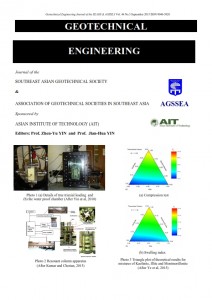Modeling Undrained Shear Behavior of Reconstituted Clays considering the Effects of Initial Water Contents
Main Article Content
Abstract
This paper presents a new model for describing the undrained shear behavior of reconstituted clays due to the variation of initial water contents based on the concept of critical state soil mechanics. With the decrease of initial water contents, the reconstituted clays behave enhanced strength, stiffness and dilation, which are not involved in the Modified Cam Clay model. These features can be captured by introducing a new hardening parameter (‘quasi-structure’ strength) into the conventional critical state model. The ‘quasi-structure’ strength increases with the decrease of initial water contents. The available test data on the undrained shear behavior of reconstituted clays at different initial water contents are used to verify the proposed model, and the comparisons between computed and measured results show that the proposed model is able to predict the overall pattern of stress-strain curves, pore pressure variations and effective stress paths reasonably well, especially the ultimate undrained strength and pore pressure response at large strain.
Article Details

This work is licensed under a Creative Commons Attribution-NonCommercial-NoDerivatives 4.0 International License.
Copyright © 2019 Association of Geotechnical Societies in Southeast Asia (AGSSEA) - Southeast Asian Geotechnical Society (SEAGS).


